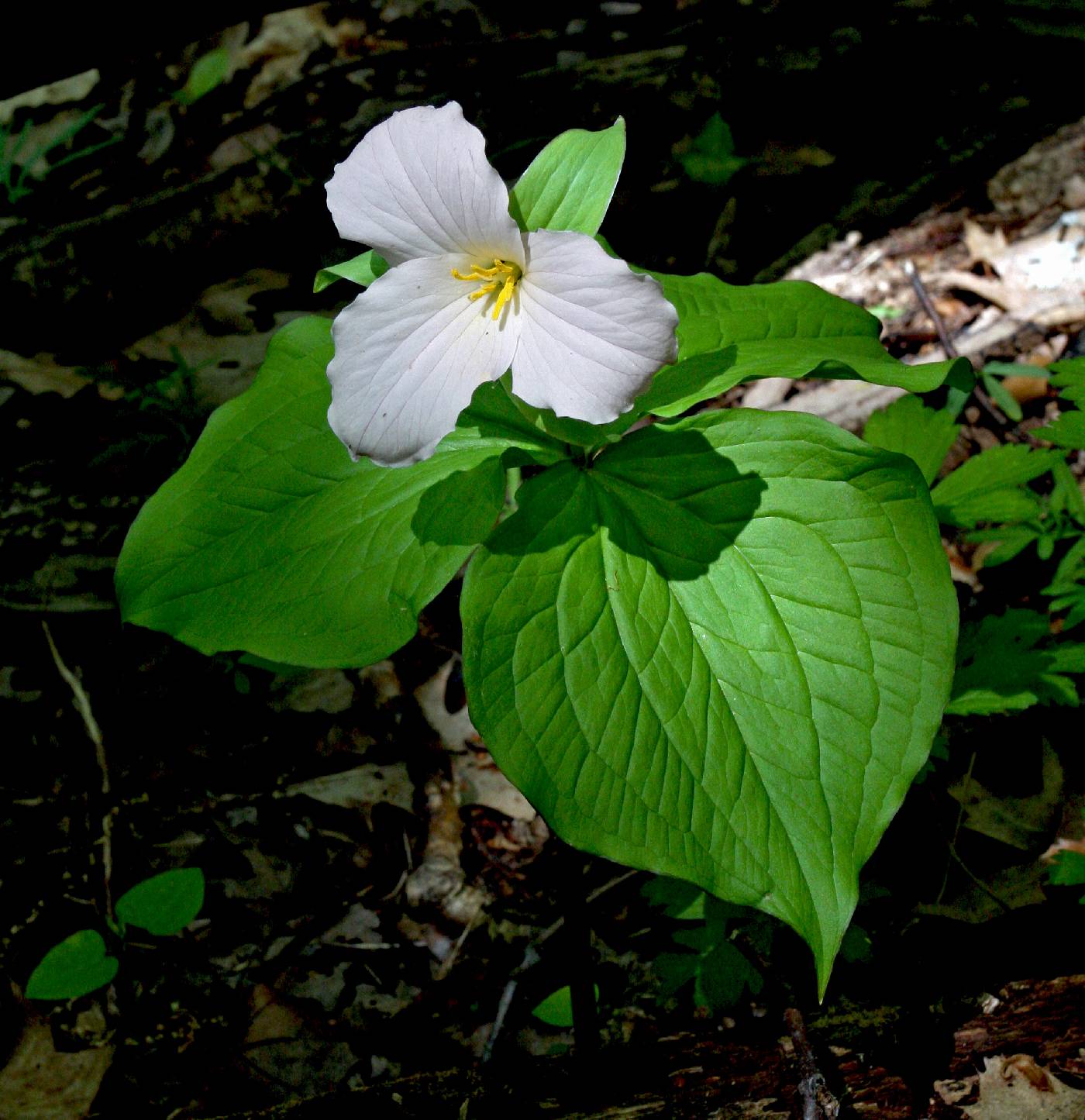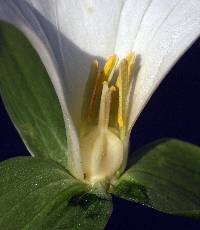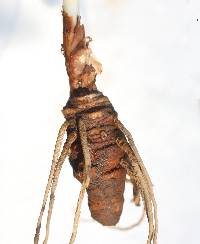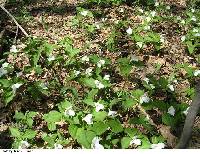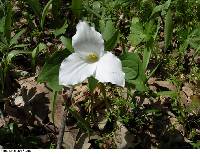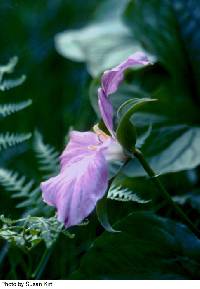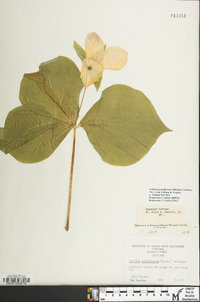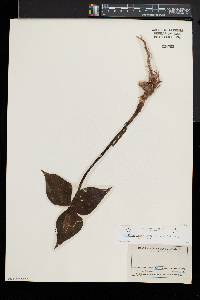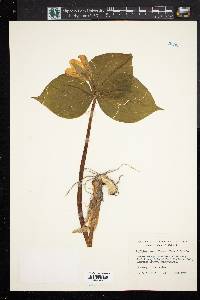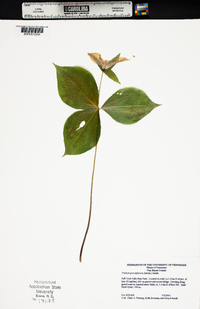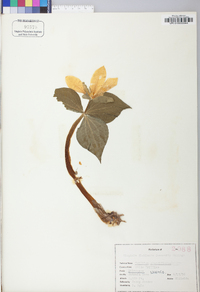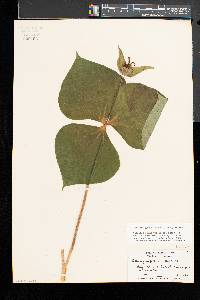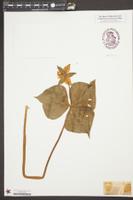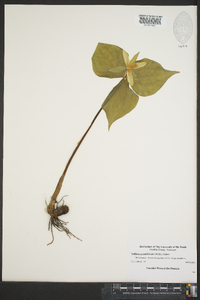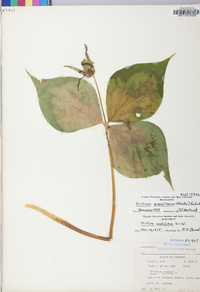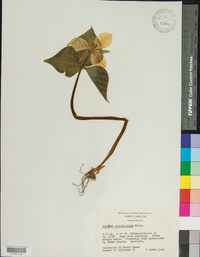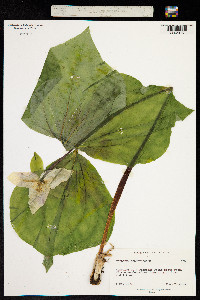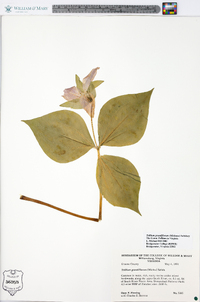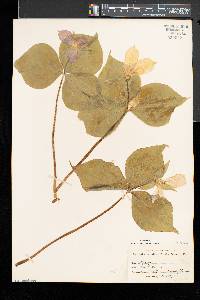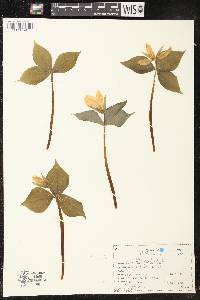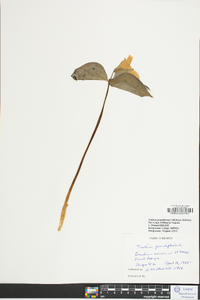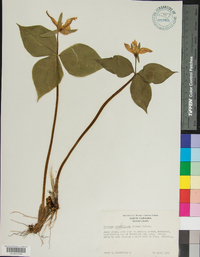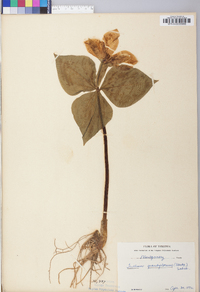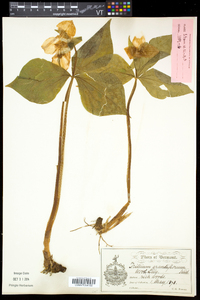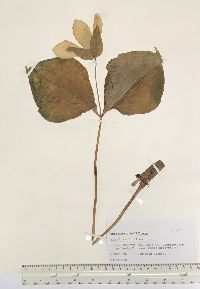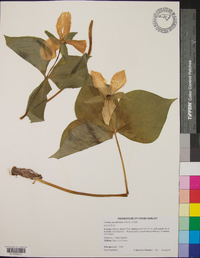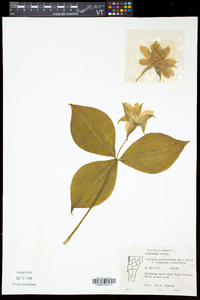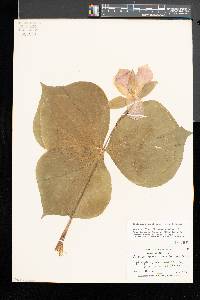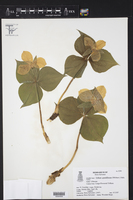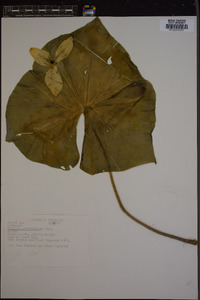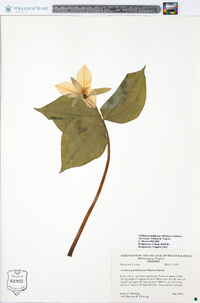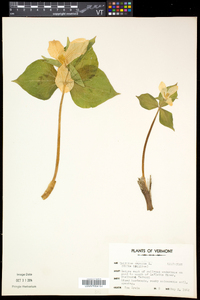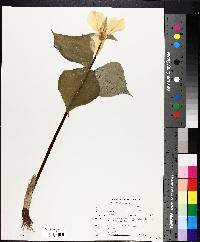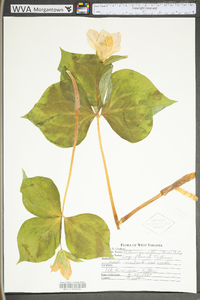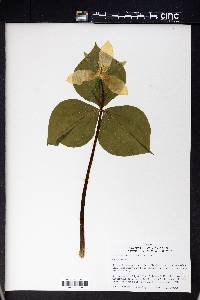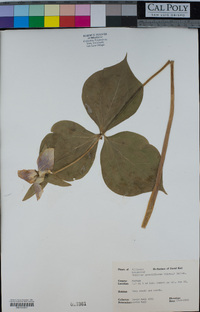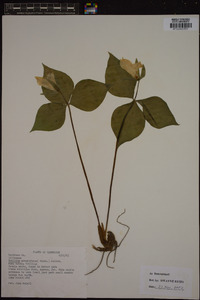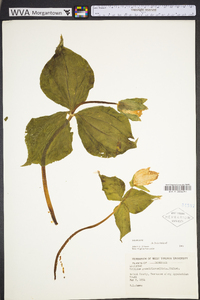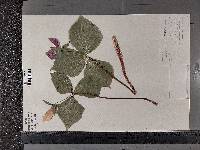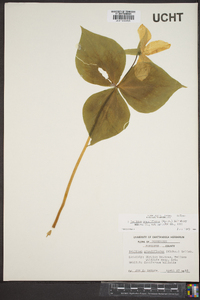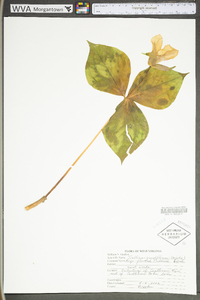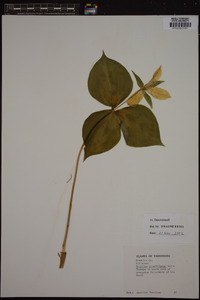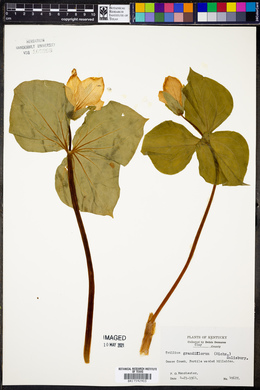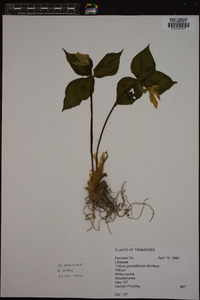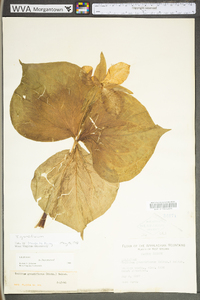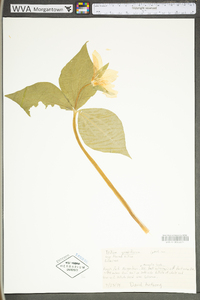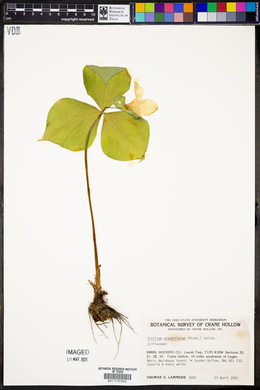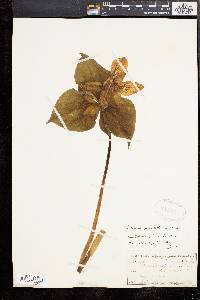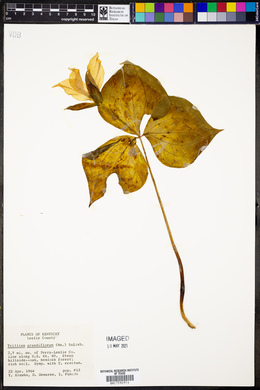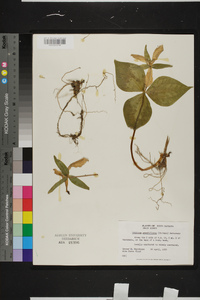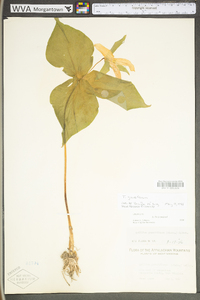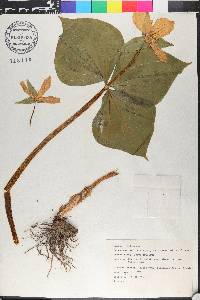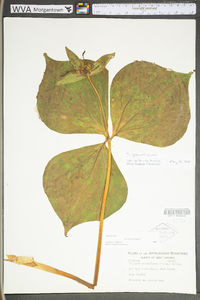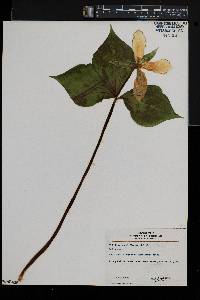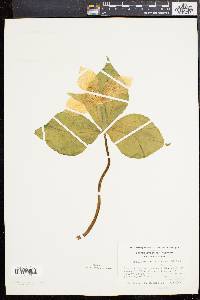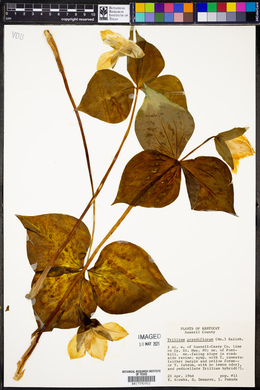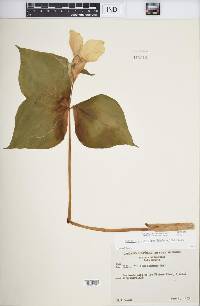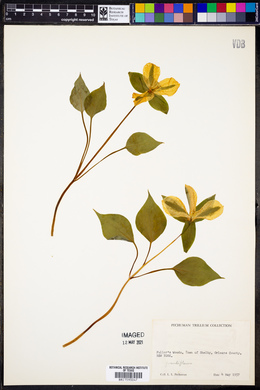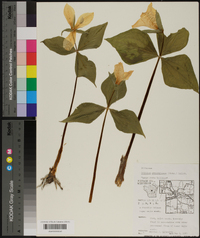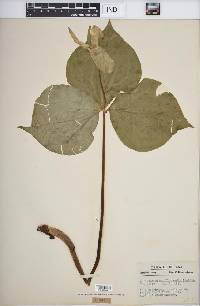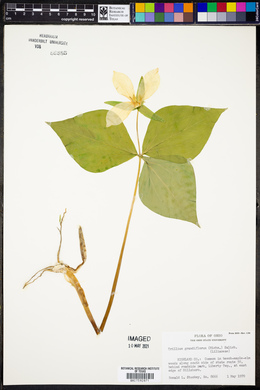
|
|
|
|
Family: Melanthiaceae
Large-Flower Trillium, more...great white trillium
[Trillium erythrocarpum, moreTrillium grandiflorum f. chandleri (Farw.) Vict., Trillium grandiflorum f. lirioides (Raf.) Vict., Trillium grandiflorum f. petalosum Louis-Marie, Trillium grandiflorum f. polymerum Vict., Trillium grandiflorum f. roseum Farw.] |
Rhizomes short, thick, praemorse. Scapes (1-)2-3(-many), round in cross section, 1.5-3+ dm, thick, glabrous. Bracts sessile or subsessile (occasionally weakly cuneate basally); blade dark green with maroon overtones early, ovate-rhombic, 12-20 × 8-15 cm, apex acuminate. Flower outfacing, erect, odorless; sepals spreading, flat, green, very rarely streaked with maroon-purple, lanceolate, 20-55 × 12-23 mm, margins entire, apex acuminate or acute; petals erect basally, recurving somewhat above middle to produce strongly funnelform corolla, obscuring ovary and base of style, white or rarely pink, without V-shaped or other markings, fading to dull pinkish purple, veins of adaxial surface conspicuous but not appearing engraved, shape variable, lanceolate to oblong, obovate, or, rarely, suborbicular, sides often parallel, 4-7.5 × 2-4 cm, thin-textured, base abruptly attenuate, margins overlapping basally, rolled, undulate-wavy in distal 1/2, apex ± acuminate; stamens straight or barely recurved, 9-27 mm; filaments white, much shorter than anthers, relatively thin; anthers recurving slightly, pale yellow, strongly yellow when pollen exposed, long, 5-16 mm, slender, dehiscence introrse; ovary inconspicuous, pale green or white, ovoid, 6-angled, 8-18 mm, basal attachment narrower than ovary width; style barely united for 0.5-2 mm or merely closely grouped and separate; stigmas erect, becoming spreading, weakly connate basally, pale green-white, uniformly linear, 3-18 mm, equaling or exceeding ovary, slender; pedicel erect-ascending to strongly erect, 2-8+ cm. Fruits pale green, odorless, ± globose, obscurely 6-angled, 1.2-1.6 × 0.8-1.4 cm, mealy, moist (not juicy). 2n = 10. Late spring--early summer (Apr--Jun). Rich deciduous or mixed coniferous-deciduous upland woods, floodplains, roadsides; 20--700 m; N.S., Ont., Que.; Conn., Del., Ga., Ill., Ind., Iowa, Ky., Maine, Md., Mass., Mich., Minn., N.H., N.J., N.Y., N.C., Ohio, Pa., S.C., Tenn., Vt., Va., W.Va., Wis. Most variants of Trillium grandiflorum have green stripes or markings on the petals, many with numerous (4-30+) extra petals and/or bracts, and, often, much-deformed, monstrous characteristics. G. R. Hooper et al. (1971) showed that mycoplasmic organisms were present in all such forms examined, and were absent from normal plants. Most such forms should not be named taxonomically but, unfortunately, many have been. Nearly all of those that I examined represented stages in the development of the mycoplasma infection. Trillium grandiflorum, unlike most trilliums, produces many-petaled 'double' forms. Forma roseum Farwell, opening a striking clear salmon-pink, occurs very rarely throughout the range, but is frequent in mixed or pure colonies along the Blue Ridge Mountains of Virginia.
Perennial herb with a short, stout rhizome stem 20 - 40 cm tall Flowers: single, held above the leaves, with six distinct tepals. Flower stalk upright-ascending to strongly upright, 2 - 8 cm long. Stamens six, alternating in two whorls of three. Sepals: three, persistent, 2 - 5.5 cm long, 1.2 - 2.3 cm wide, shorter than the petals, lance-shaped, flat, ascending to spreading. Petals: three, white, turning pinkish with age, 4 - 8 cm long, 2 - 4 cm wide, longer than the sepals, reverse egg-shaped to elliptic with a pointed tip (the shape is variable), forming a short funnel basally then flaring out (spreading or slightly recurved), shriveling after the flowering period. Fruit: a many-seeded berry, pale green, 1.2 - 1.6 cm long, 0.8 - 1.4 cm wide, more or less spherical, obscurely six-angled, mealy, not juicy, odorless. Seeds many, elliptic. Similar species: The stalkless (or nearly stalkless) leaves and upright or ascending flower stalks distinguish this species and Trillium erectum from all other Trillium species. Trillium erectum differs by having a bad-smelling flower that is typically maroon. Flowering: April to early June Habitat and ecology: Locally frequent in moist woodlands. It is locally common in the swampy woodlands of the dune area. Occurence in the Chicago region: native Notes: Trilliums do not actually have true leaves or stems above the ground. The underground rhizome produces scale-like leaves called cataphylls. The aboveground leaf-like structures are bracts that subtend the flower, but these are internally and externally similar to leaves and function in photosynthesis. Many authors will refer to them as leaves. Etymology: Trillium comes from the Greek word trilix, meaning triple, referring to how all the plant parts occur in threes. Grandiflorum means large-flowered. Author: The Morton Arboretum Stem 2-4 dm at anthesis; lvs ovate or rhombic or subrotund, at an thesis 8-12 cm, short-acuminate, narrowed from below the middle to an acute base (rarely short-petioled); peduncle erect or declined, 5-8 cm, the fl held above the lvs; sep lanceolate, ascending-spreading, 3-5 cm; pet normally white, turning pink in age, ascending from the base, spreading above, obovate or elliptic, evidently longer than the sep, 4-8 cm, acute; filaments more than half as long as the introrse anthers and scarcely (if at all) wider, the whole stamen 15-25 mm; stigmas slender, erect, slightly shorter than the white, 6-winged and -sulcate ovary; 2n=10. Rich moist woods; Que. and Me. to Minn., s. to Pa., O., and Ind., and in the mts. to n. Ga. and ne. Ala. Apr., May. Gleason, Henry A. & Cronquist, Arthur J. 1991. Manual of vascular plants of northeastern United States and adjacent Canada. lxxv + 910 pp. ©The New York Botanical Garden. All rights reserved. Used by permission. From Flora of Indiana (1940) by Charles C. Deam This species is frequent in the northeastern part of the state, becoming infrequent to rare southward. Friesner reports it from Harrison County. It is found mostly in moist woods and is also found in springy places in woods, on moist, wooded slopes, and in marshes. …… Indiana Coefficient of Conservatism: C = 8 Wetland Indicator Status: N/A |
|
|
|

